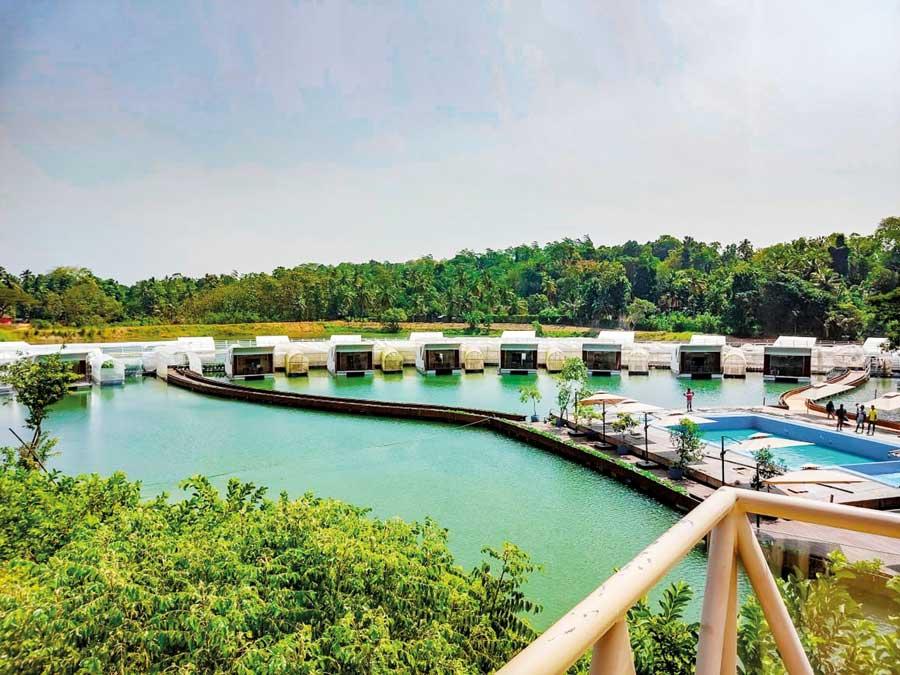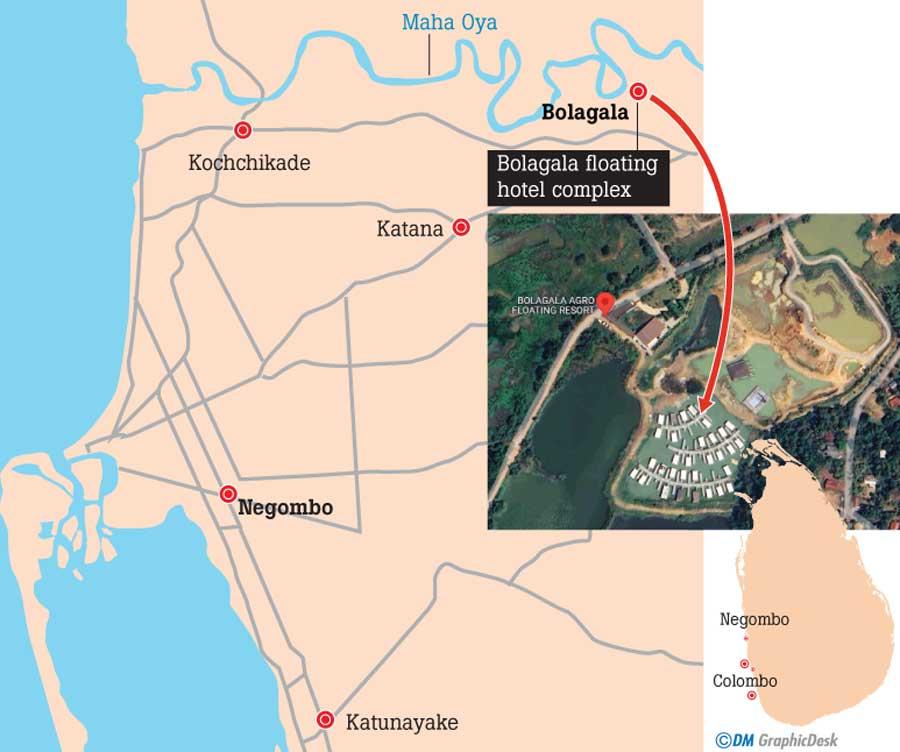Reply To:
Name - Reply Comment

The hotel project after reaching its completion
- When the proposal to construct the floating hotel was initially presented, the Central Environmental Authority questioned Kelum Perera about its feasibility
- The designer of this facility claims that it is the first time that a floating hotel complex has been constructed featuring all facilities in one place
The primary source of income for the people in Bolagala area in Negombo was the clay industry. The manufacture of clay-related products such as tiles and bricks enhanced their livelihoods. Despite the prosperity resulting from their involvement in the clay industry, large pits, measuring 40-50 feet deep, were dug to extract clay from around 200 acres of land. Consequently, significant environmental damage could be observed in Bolagala.
livelihoods. Despite the prosperity resulting from their involvement in the clay industry, large pits, measuring 40-50 feet deep, were dug to extract clay from around 200 acres of land. Consequently, significant environmental damage could be observed in Bolagala.
Although profits were generated from clay production, what remains in the area today are not expanses of land, but rather pits filled with water, resembling small lakes from a distance. After the clay extraction, the pits were not adequately refilled with soil; allowing water to accumulate. Large pits spanning hundreds of acres were excavated for clay extraction, but the failure to properly close them resulted in significant environmental damage.
Pits in those lands needed either large amounts of soil or sand to be fully covered. This required bringing soil and sand from other areas; which was both costly and time-consuming. Consequently, an alternative solution to mitigate this environmental damage was explored. A person by the name of Kelum Perera, who was once involved in the clay industry, proposed constructing a floating hotel complex on the land spreading for hundreds of acres. The land was subject to excavating activities and was in a destroyed state. Initially, it appeared to be a promising endeavour, but as the project commenced, it became burdensome as there was little interest in the floating hotel complex.
200 direct and indirect job opportunities
When the proposal to construct the floating hotel complex was initially presented, the Central Environmental Authority questioned Kelum Perera about its feasibility in Sri Lanka and requested a sample floating hotel room to be produced for demonstration. Despite the submission of the plan- after the prototype’s creation- immediate approval for the project wasn’t guaranteed. Numerous obstacles arose, stemming from both government officials and political influences. A prominent politician, who operates a sand refinery in the area, also joined in opposing the construction of the floating hotel complex. As a result, the construction of the hotel complex was subject to a delay of about a year. Upon the completion of the floating hotel complex and its utilization of water from the clay pits, insufficient water remained for the sand purification operations of the said politician. Refusing to halt sand refining activities due to the hotel, the politician sought to portray the hotel construction as creating environmental damage in the area, according to Kelum Perera.
“It was shown that upon the construction of the hotel, all its waste will be disposed of into the water in the pits; resulting in another environmental issue. Additionally, the floating hotel complex requires continuous access to water. In this context, it was alleged that the spring water of the area will be utilized for these pits; leading to a shortage of water for the villagers, even for drinking purposes. Claims were made that following the construction and opening of the hotel, villagers will find themselves unemployed, as there will no longer be any area left for clay excavation. The politician worked to rally villagers against the project. There were many such accusations. After the construction of the hotel there were accusations that the water was drained by excavating the banks using backhoes. All efforts were aimed at halting its construction. Despite encountering these obstacles, I built the world’s first floating hotel complex,” said Kelum Perera.
“The politician worked to rally villagers against the project. There were many such accusations. After the construction of the hotel there were accusations that the water was drained by excavating the banks using backhoes. All efforts were aimed at halting its construction. Despite encountering these obstacles, I built the world’s first floating hotel complex”
- Kelum Perera, Designer of the hotel
Hotel rooms, restaurants and swimming pools-made using the concept of floating structures- exist separately around the world. However, for the first time ever, a floating hotel complex has been constructed with all facilities in one place. “This concept emerged based on my idea of revitalizing the area, that had been excavated and left barren. The Geological Survey & Mines Bureau spearheaded this initiative and provided comprehensive support throughout the process,” he said. According to Perera, he and his team had successfully overcame numerous obstacles along the way; not forgetting the help offered by the local authorities.
“It is worth acknowledging that the world’s first floating hotel complex was exclusively created using local technology and under the supervision of local engineers. Situated in a vast clay pit spanning 13 acres, this hotel, named Bolagala Agro Floating Resort, stands as the first ever floating hotel complex. Approximately 2 billion rupees was spent on this project; exceeding the initially planned budget of 1.25 billion rupees. The 13-acre site of the hotel has depths ranging from 30 to 50 feet. This hotel has 37 rooms, including 10 separate floating rooms managed through GPS technology. Moreover, the fiberglass swimming pool and restaurant can be relocated as desired. Visitors can dine, bathe, and sleep while floating, and also enjoy services such as massages done underwater. The resort also offers an array of amenities, including water sports and bike rides,” said Perera.
When visiting this area, one can experience that the natural environment hasn’t been disturbed. All the waste generated by the hotel is repurposed as organic fertilizer for cultivation. Following the greenhouse concept, fruits and vegetables are cultivated alongside each room; allowing tourists to pick and enjoy them at their leisure. Additionally, through fish, crab, and shrimp farming, visitors can satisfy their seafood cravings in keeping with their preferences.
Booking a room at this hotel might cost a guest around US$ 400. “Our primary objective is to attract tourists who would otherwise visit countries like Malaysia and the Maldives. The company’s goal is to bring revenue to the country and provide tourists with an unforgettable experience. The new hotel complex has the potential to generate more income than the closed down section of the clay industry which, when operated, was done in a manner that damaged the environment,” he said.
This hotel project has topped the list in the world’s best project selection programme which was organised by the World Bank. Perera said that the World Bank had donated 500,000 US$ to aid the construction of this facility. Additionally, in line with the hotel concept, a rural village setting has been introduced. Here, an old village featuring traditional medicinal practices, traditional industries, sweets, and food will be available throughout the day. It is noteworthy that a village, complete with a village headman and Bali, Thovil, Shanthikarma and handicraft industry, has been established as part of this initiative.
“While many focus on building hotels, we took to this project from a different angle. Our primary goal is to position this hotel as a focal point of conversation within Sri Lanka’s tourism industry. Making a significant contribution to the advancement of tourism in Sri Lanka would be where we are heading in terms of success,” he said. Perera also mentioned that this hotel has created approximately 200 direct and indirect job opportunities for the local community.
The local engineers who designed this hotel complex also prioritised addressing security during heavy rains and floods. Even during a severe shower the water does not infiltrate hotel rooms and the complex remains stable without overturning or other risks if water levels rise or there are floods. Additionally, the hotel has been uniquely designed so that in the event of the pits filling with water due to heavy rain or flooding, the structure will rise along with the water level.
“Restoring a devastated environment to its green state is no simple task, but we have successfully accomplished that. We’ve planted valuable woody and medicinal plants around the hotel. Additionally, guests staying at this hotel will experience an atmosphere more akin to a farm than a traditional hotel,” said Perera adding that being able to rejuvenate a once-destroyed environment in this manner is truly a triumph.
